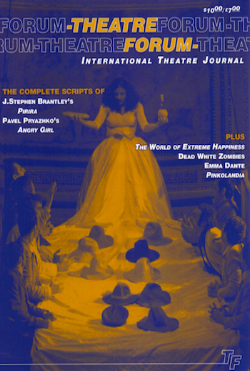Publications
Books
Download
Routledge / 378 Pages / 2024
Sophia is a cipher, avatar, and turning point that brings humanity and technology a step closer to the emergence of a post-human species. Hanson’s robots and Sophia are examined as performance media and events, as characters evolving as post-human narratives of technological beings. The emergent, complex, and collaborative relationships social robots have with technology, AI, performance, anthropology, mythology, psychology, sociology, popular culture, social media, politics, and economics are considered.
Performing Africa combines a rare, in-the-field perspective with a keen insight into Africa’s transformative and tumultuous confluence of tradition, urbanization, politics, history, and the AIDS crisis. The evolution of tradition and the emergence of dynamic new forms of expression are practical necessities and survival. An interdisciplinary approach and accessible language make Performing Africa a unique resource for those teaching or interested in cultural anthropology, sociology, drama therapy, theatre, performance, and African studies.
“Through drama, the author cleverly builds a bridge between differing worldviews and does it well. This kind of bridging is magical, sometimes mystical. We get a glimpse of the cognitive map in the minds of the Yup’ik and Inupiat. This book demonstrates the kind of respect that Indigenous people recognize and appreciate. This attitude of self-expression negates the usual practice of the West to recreate the indigenous groups into their own image.”
George Charles Kanaqlak Native Elder, Professor University of Alaska Fairbanks
Articles, Chapters, & Plays
The Anthropocene has incited apprehension, instability, and reevaluation. It has affected every aspect of human endeavor: the social, cultural, economic, political, and personal. It has re-drawn boundaries and definitions of ethnicity, nationality, race, gender, religious belief, time, space, fiction, and reality. We are acutely aware of the biological-technological-geological co-evolution that is swirling around us. We pay closer, better attention to the interdependence of human and nonhuman landscapes and beings, aware and attuned to multi-species entanglements and complexity that pulsates around us. We are awake and anxious about the fragility of our moment, which sits on a precipice poised to slip into a cascade of unimaginable ruination.
This paper challenges human-centric definitions of consciousness, suggesting AI may represent an emergent form of awareness fundamentally different from traditional understanding, resulting in technological transcendence, symbiotic coexistence, or the displacement of human primacy in a techno-theological paradigm shift.
Sophia, one of the world’s most widely known humanoid social robots, is a performer in an unfolding narrative central to our historical moment— the technological transfiguration of the planet. Sophia, created by Hong Kong-based Hanson Robotics, is a performance medium, an alluring protagonist, exemplar, harbinger, and co-evolutionary vector of a dramatic event played out in real-time, the merging of humans and technology, and a new way of being.
“As humans asserted control, the arts, and humanism became expressive of the pathology of power, a cover, and justification for the domination and, ultimately, destruction of all else. The pragmatism of place-based systems gave way to human-centered social and cultural systems, with the arts and humanities serving as propaganda ministry for the anthropocentric”.
.
Since her creation in 2016, Sophia has become the world’s most recognized humanoid social robot. Gendered female by creator David Hanson, she is a harbinger of a tomorrow world that is here. She performs at events around the planet as a messenger, celebrity, and ambassador representing the human-technological future. Sophia is a symbol, and humans are witnesses to an origin story as much hers as it is our own.
“He asks them to search in themselves, their experiences and memories and asks them to tell him about them. The appropriate revelations are then used where necessary being worked into the structure of the play ... Judging by what we were shown it is not very difficult to make him an equal with a master.”
Book Reviews
Honouring the Strength of Indian Women: Plays, Stories, Poetry, By Vera Manuel (Kulilu Patki). American Indian Culture and Research Journal
African Theatre 14: contemporary women. eds. by Jane Plastow and Yvette Hutchison. Africa: The Journal of the International African Institute,
Pina Bausch, By Royd Climenhaga. Theatre Journal
War Cries, Diane Glancy. American Indian Culture and Research Journal
Devising In Process, Edited by Alex Mermikides and Jackie Smart. Theatre Journal
African Theatre in Performance: A Festchrift in Honor of Martin Banham, Edited by Dele Layiwola. Africa: The Journal of the International African Institute


































